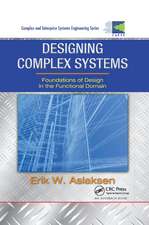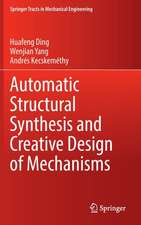The System Concept and Its Application to Engineering
Autor Erik W. Aslaksenen Limba Engleză Hardback – 7 sep 2012
Systems engineering is a mandatory approach in some industries, and is gaining wider acceptance for complex projects in general. However, under the imperative of delivering these projects on time and within budget, the focus has been mainly on the management aspects, with less attention to improving the core engineering activity – design. This book addresses the application of the system concept to design in several ways: by developing a deeper understanding of the system concept, by defining design and its characteristics within the process of engineering, and by applying the system concept to the early stage of design, where it has the greatest impact.
A central theme of the book is that the purpose of engineering is to be useful in meeting the needs of society, and that therefore the ultimate measure of the benefit of applying the system concept should be the extent to which it advances the achievement of that purpose. Consequently, any consistent, top-down development of the functionality required of a solution to the problem of meeting a defined need must proceed from such a measure, and it is agued that a generalised form of Return on Investment is an appropriate measure. A theoretical framework for the development of functionality based on this measure and utilising the system concept is presented, together with some examples and practical guidelines.
| Toate formatele și edițiile | Preț | Express |
|---|---|---|
| Paperback (1) | 639.73 lei 6-8 săpt. | |
| Springer Berlin, Heidelberg – 15 oct 2014 | 639.73 lei 6-8 săpt. | |
| Hardback (1) | 642.51 lei 6-8 săpt. | |
| Springer Berlin, Heidelberg – 7 sep 2012 | 642.51 lei 6-8 săpt. |
Preț: 642.51 lei
Preț vechi: 755.88 lei
-15% Nou
Puncte Express: 964
Preț estimativ în valută:
122.94€ • 128.36$ • 101.75£
122.94€ • 128.36$ • 101.75£
Carte tipărită la comandă
Livrare economică 04-18 aprilie
Preluare comenzi: 021 569.72.76
Specificații
ISBN-13: 9783642321689
ISBN-10: 3642321682
Pagini: 250
Ilustrații: XIV, 270 p.
Dimensiuni: 155 x 235 x 23 mm
Greutate: 0.48 kg
Ediția:2013
Editura: Springer Berlin, Heidelberg
Colecția Springer
Locul publicării:Berlin, Heidelberg, Germany
ISBN-10: 3642321682
Pagini: 250
Ilustrații: XIV, 270 p.
Dimensiuni: 155 x 235 x 23 mm
Greutate: 0.48 kg
Ediția:2013
Editura: Springer Berlin, Heidelberg
Colecția Springer
Locul publicării:Berlin, Heidelberg, Germany
Public țintă
ResearchCuprins
Introduction .-
PART A THE SYSTEM CONCEPT.-
A1 Everyday Use and Meaning.-
A2 The Philosophical Context.-
A3 The System Concept Within the Philosophical Framework.-
A4 Some Features of the System Concept.-
A5 Applying the System Concept.-
.
PART B ENGINEERING.-
B1 A Short History.-
B2 Characteristics of Engineering.-
B3 Usefulness – The Purpose of Engineering.-
B4 Design and Creativeness.-
B5 Requirements Definition.-
B6 Standardisation and the Bottom-Up Design Process.-
B7 Managing the Process of Engineering.-
PART C APPLYING THE SYSTEM CONCEPT TO ENGINEERING.-
C1 Sources of Complexity.-
C2 The Systems Engineering Approach to Handling Complex Projects.-
C3 Architecting and Functional Analysis.-
C4 The Functional Domain.-
C5 Systems in the Functional Domain.-
C6 Value and Optimisation.
A1 Everyday Use and Meaning.-
A2 The Philosophical Context.-
A3 The System Concept Within the Philosophical Framework.-
A4 Some Features of the System Concept.-
A5 Applying the System Concept.-
.
PART B ENGINEERING.-
B1 A Short History.-
B2 Characteristics of Engineering.-
B3 Usefulness – The Purpose of Engineering.-
B4 Design and Creativeness.-
B5 Requirements Definition.-
B6 Standardisation and the Bottom-Up Design Process.-
B7 Managing the Process of Engineering.-
PART C APPLYING THE SYSTEM CONCEPT TO ENGINEERING.-
C1 Sources of Complexity.-
C2 The Systems Engineering Approach to Handling Complex Projects.-
C3 Architecting and Functional Analysis.-
C4 The Functional Domain.-
C5 Systems in the Functional Domain.-
C6 Value and Optimisation.
B1 A Short History.-
B2 Characteristics of Engineering.-
B3 Usefulness – The Purpose of Engineering.-
B4 Design and Creativeness.-
B5 Requirements Definition.-
B6 Standardisation and the Bottom-Up Design Process.-
B7 Managing the Process of Engineering.-
PART C APPLYING THE SYSTEM CONCEPT TO ENGINEERING.-
C1 Sources of Complexity.-
C2 The Systems Engineering Approach to Handling Complex Projects.-
C3 Architecting and Functional Analysis.-
C4 The Functional Domain.-
C5 Systems in the Functional Domain.-
C6 Value and Optimisation.
C1 Sources of Complexity.-
C2 The Systems Engineering Approach to Handling Complex Projects.-
C3 Architecting and Functional Analysis.-
C4 The Functional Domain.-
C5 Systems in the Functional Domain.-
C6 Value and Optimisation.
PART A THE SYSTEM CONCEPT.-
A1 Everyday Use and Meaning.-
A2 The Philosophical Context.-
A3 The System Concept Within the Philosophical Framework.-
A4 Some Features of the System Concept.-
A5 Applying the System Concept.-
.
PART B ENGINEERING.-
B1 A Short History.-
B2 Characteristics of Engineering.-
B3 Usefulness – The Purpose of Engineering.-
B4 Design and Creativeness.-
B5 Requirements Definition.-
B6 Standardisation and the Bottom-Up Design Process.-
B7 Managing the Process of Engineering.-
PART C APPLYING THE SYSTEM CONCEPT TO ENGINEERING.-
C1 Sources of Complexity.-
C2 The Systems Engineering Approach to Handling Complex Projects.-
C3 Architecting and Functional Analysis.-
C4 The Functional Domain.-
C5 Systems in the Functional Domain.-
C6 Value and Optimisation.
A1 Everyday Use and Meaning.-
A2 The Philosophical Context.-
A3 The System Concept Within the Philosophical Framework.-
A4 Some Features of the System Concept.-
A5 Applying the System Concept.-
.
PART B ENGINEERING.-
B1 A Short History.-
B2 Characteristics of Engineering.-
B3 Usefulness – The Purpose of Engineering.-
B4 Design and Creativeness.-
B5 Requirements Definition.-
B6 Standardisation and the Bottom-Up Design Process.-
B7 Managing the Process of Engineering.-
PART C APPLYING THE SYSTEM CONCEPT TO ENGINEERING.-
C1 Sources of Complexity.-
C2 The Systems Engineering Approach to Handling Complex Projects.-
C3 Architecting and Functional Analysis.-
C4 The Functional Domain.-
C5 Systems in the Functional Domain.-
C6 Value and Optimisation.
B1 A Short History.-
B2 Characteristics of Engineering.-
B3 Usefulness – The Purpose of Engineering.-
B4 Design and Creativeness.-
B5 Requirements Definition.-
B6 Standardisation and the Bottom-Up Design Process.-
B7 Managing the Process of Engineering.-
PART C APPLYING THE SYSTEM CONCEPT TO ENGINEERING.-
C1 Sources of Complexity.-
C2 The Systems Engineering Approach to Handling Complex Projects.-
C3 Architecting and Functional Analysis.-
C4 The Functional Domain.-
C5 Systems in the Functional Domain.-
C6 Value and Optimisation.
C1 Sources of Complexity.-
C2 The Systems Engineering Approach to Handling Complex Projects.-
C3 Architecting and Functional Analysis.-
C4 The Functional Domain.-
C5 Systems in the Functional Domain.-
C6 Value and Optimisation.
Recenzii
From the reviews:
“The book is concentrated on the understanding of systems concept by first developing an understanding of system and then applying that as the tool for thinking about complex matters. … a book for engineers who want to consider their role in developing and upgrading systems. … I would recommend this book to anyone, engineer or not, who wants to understand the system concept and its application to any activity.” (Barney Morais, Insight, Vol. 16 (1), April, 2013)
“The book is concentrated on the understanding of systems concept by first developing an understanding of system and then applying that as the tool for thinking about complex matters. … a book for engineers who want to consider their role in developing and upgrading systems. … I would recommend this book to anyone, engineer or not, who wants to understand the system concept and its application to any activity.” (Barney Morais, Insight, Vol. 16 (1), April, 2013)
Textul de pe ultima copertă
Systems engineering is a mandatory approach in some industries, and is gaining wider acceptance for complex projects in general. However, under the imperative of delivering these projects on time and within budget, the focus has been mainly on the management aspects, with less attention to improving the core engineering activity – design. This book addresses the application of the system concept to design in several ways: by developing a deeper understanding of the system concept, by defining design and its characteristics within the process of engineering, and by applying the system concept to the early stage of design, where it has the greatest impact.
A central theme of the book is that the purpose of engineering is to be useful in meeting the needs of society, and that therefore the ultimate measure of the benefit of applying the system concept should be the extent to which it advances the achievement of that purpose. Consequently, any consistent, top-down development of the functionality required of a solution to the problem of meeting a defined need must proceed from such a measure, and it is agued that a generalised form of Return on Investment is an appropriate measure. A theoretical framework for the development of functionality based on this measure and utilising the system concept is presented, together with some examples and practical guidelines.
A central theme of the book is that the purpose of engineering is to be useful in meeting the needs of society, and that therefore the ultimate measure of the benefit of applying the system concept should be the extent to which it advances the achievement of that purpose. Consequently, any consistent, top-down development of the functionality required of a solution to the problem of meeting a defined need must proceed from such a measure, and it is agued that a generalised form of Return on Investment is an appropriate measure. A theoretical framework for the development of functionality based on this measure and utilising the system concept is presented, together with some examples and practical guidelines.
Caracteristici
Demonstrates how elements of systems engineering, design, economics, or ontology can be combined in order to handle the increasing complexity of engineering projects The system concept as a mode of description is a central feature Shows why systems engineering should not be overly influenced by the formalism of software engineering





















